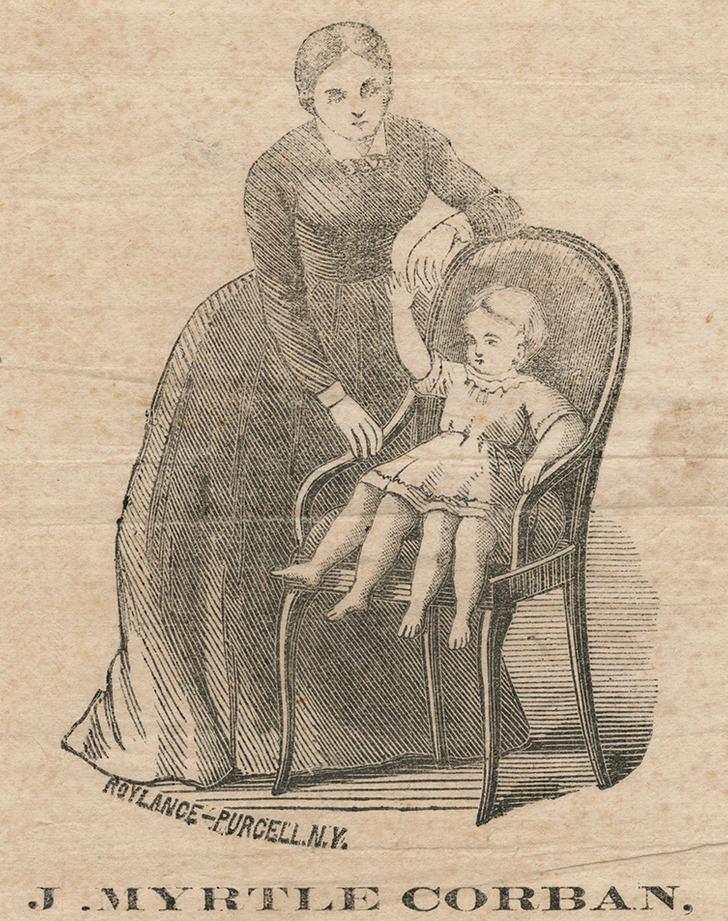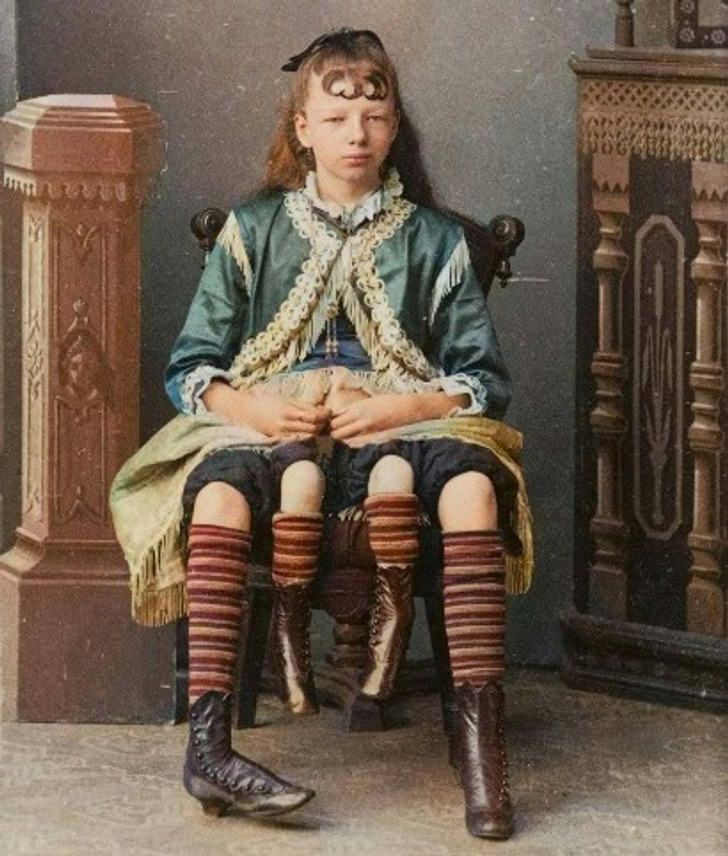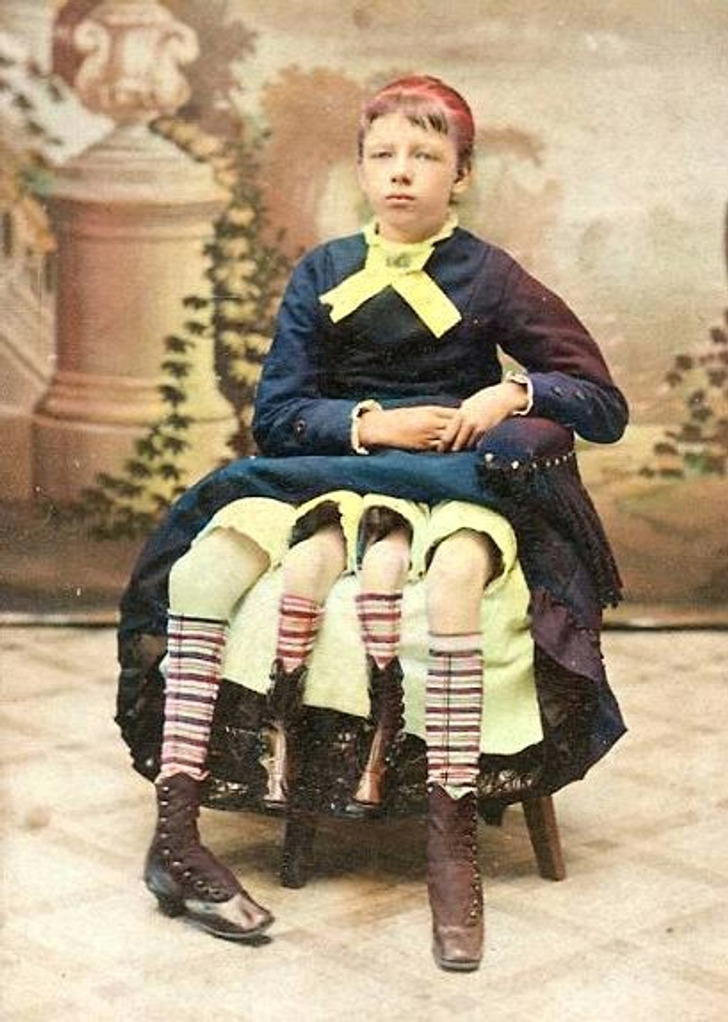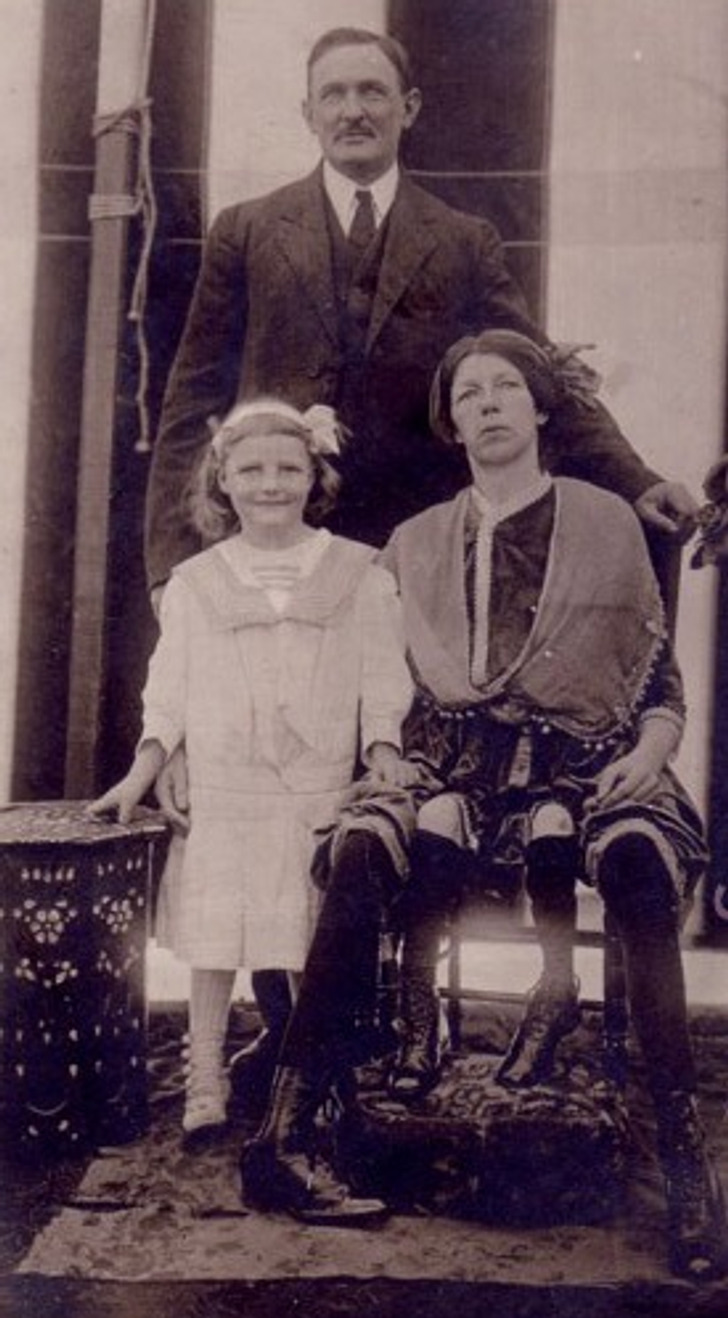Josephine Myrtle Corbin was born with a rare birth defect called polymelia, meaning born with extra limbs, in her case, she had 4 legs, 2 normal ones and 2 smaller ones that grew from her hips. But there was more to it. She also had 2 sets of reproductive organs and 2 pelvises. Because of this rare occurrence, she’s probably one of the few people in history considered wonders. Let’s delve into Myrtle’s story and discover her exceptional life milestones.Myrtle was considered a rare and remarkable case of human development.
Josephine Myrtle Corbin, an American sideshow performer, came into the world in 1868 as a remarkable medical rarity. Affected by a condition known as dipygus, she possessed two lower bodies from the waist down. This unusual phenomenon occurred due to her body axis splitting during development, resulting in two separate pelvises side by side. Remarkably, her smaller inner legs were paired with one of her outer legs. While Myrtle could move her inner legs, but they were too weak to walk on.
Born in Tennessee to her parents, William and Nancy, Myrtle’s arrival brought both wonder and concern. At 25, her father, William, and 34-year-old mother, Nancy, welcomed the unique little Myrtle into their lives. Medical professionals noted that if Myrtle had been delivered breech, with her bottom first, it could have been potentially fatal for both her and her mother. Thankfully, Myrtle’s early days were promising, as she displayed signs of strength, weighing 10 lb (4.5kg) just 3 weeks after her birth.
Myrtle’s father was facing financial hardship and had to think of ways to support his growing family.

© Charles Eisenmann (1855-1927) / Wikimedia Commons, © Public domain, © Palette.fm
At the age of 5 weeks, people had the opportunity to visit William Corbin and marvel at his four-legged daughter for a small fee. As the years passed, Myrtle grew up accustomed to the constant stares and astonishment from those who encountered her rare condition. Her inner legs never fully developed, her right foot was clubbed, and both of the smaller legs had 3 toes on each foot.
Over the following decade, William took Myrtle on a journey across the country, where she participated in fairs, sideshows, and dime museums. By the time she turned 14, she had achieved success and managed to secure a lucrative contract paying her an unusually high salary of $250 per week.
The four-legged girl, Myrtle, had a younger sister named Ann, who fortunately did not suffer from any birth defects.
Myrtle married when she was 18 and later became a mother.

© James R. Applegate (1849–1910), Philadelphia / Wikimedia Commons, © Public Domain, © Palette.fm
As Myrtle entered adulthood, she grew weary of the constant attention she received due to her condition. At 18, she decided to marry James Bicknell, a medical student, after which she retired from her performing career. Interestingly, her fame had inspired others to attempt to fake her unique deformity, but all of these impostors were eventually exposed as frauds.
A year into their marriage, Myrtle experienced troubling symptoms like fever, nausea, headaches, and side pains. Concerned, she sought medical attention, and to her disbelief, the doctor revealed that she was pregnant on her left side. Myrtle skeptically responded, saying, “If it had been on my right side, I would come nearer believing you are correct.” The pregnancy proved challenging for her health, and doctors even advised her to consider an abortion due to the severity of her illness. However, Myrtle managed to recover swiftly.
Over the following years, James and Myrtle welcomed seven more children into their family. Tragically, only 5 of them survived infancy, 4 daughters and a son.
© Unknown author / Wikimedia Commons, © Public Domain
The family lived a quiet life until their 5 children reached adulthood. Then Myrtle re-entered the show business. In 1909, when Myrtle was 41, she was a part of Huber’s Museum exhibit, appearing as The Four-Legged Girl from Cleburne, Texas. She often dressed her 4 legs in matching shoes and socks, to the audience’s delight. She was making $450 per week at the time.
In 1928, Myrtle developed a skin infection on her right leg, and the doctor diagnosed her with erysipelas or a strep infection. A week later, on May 6th, 1928, Myrtle passed away. Her casket was covered in concrete, and family members kept watch until it was fully cured to prevent grave robbers from stealing her remains.
Almost a century later, Josephine Myrtle Corbin Bicknell continues to inspire others by proving that even in the 19th century, a woman could forge a successful career and become a mother all at once.
World’s Most Jaw-Dropping ‘Man-aconda’ Discovery Will Leave You Speechless!
The animal world is full of surprises, with some creatures being more eye-catching than others because of their strange looks or unusual nature.
When I first saw a picture of this weird “penis snake,” I thought it was a joke. But, to my surprise, it turned out to be a real animal. So, let’s dive into the story behind the viral image that has left thousands of people in shock.
Throughout history, anything shaped like a phallus has grabbed attention and sparked curiosity. A few years ago, images of a strange-looking creature started making the rounds online, leaving many people scratching their heads in disbelief.
With its unique appearance, this mysterious animal quickly earned nicknames like the “penis snake,” “blind snake,” or the “man-aconda.”
But no, it’s not what you think.
Even though it looks a lot like a snake, this creature is actually called *Atretochoana eiselti*. It’s not a snake at all, but an amphibian, more closely related to a salamander. It’s also the largest known lungless tetrapod, which means it breathes through its skin instead of lungs.
This rare animal lives in the waters of the Amazon in Brazil and was hard to find for a long time. It was first discovered by Sir Graham Hales during an expedition with Sir Brian Doll in the late 1800s.
However, it wasn’t officially described until 1968. After more research, scientists reclassified it in 1996, giving it its own unique genus, *Atretochoana*.
In 2011, this species was rediscovered in the Amazon region. It lives only in the Amazon River and its largest tributary, the Madeira River in Brazil. The “penis snake” has only been found in this area and nowhere else in the world.
The viral pictures that blew up the internet a few years ago actually came from 2011. That’s when a whole family of these phallic-shaped creatures was found at the bottom of the Madeira River in Brazil. They were discovered when the river was drained during work on a hydroelectric dam.
Julian Tupan, a biologist working with the Santo Antonio Energy company on the dam, explained that not much is known about these lungless, limbless amphibians.
“Out of the six we collected, one died, three were released back into the wild, and two were kept for study,” he told *Estadao*, according to the U.K.’s *The Sun*.
Tupan pointed out that these “snakes” aren’t dangerous and are unlikely to show any aggressive behavior.
“Even though they look like snakes, they’re not reptiles; they’re more closely related to salamanders and frogs. We think the animal breathes through its skin and probably eats small fish and worms, but that hasn’t been proven yet.
“The Amazon is full of surprises when it comes to reptiles and amphibians. There’s still a lot more to discover.”
The most popular photo, which Julian Tupan shared on Instagram, shows an adult female *A. eiselti* that’s just under 40 inches long.
Even though these creatures are fascinating, there’s still a lot we don’t know about them. One mystery that puzzles researchers is their diet. Scientists think these phallic-shaped animals might eat small fish, worms, and other aquatic invertebrates, but more research is needed to confirm this.
 Wikipedia Commons / Tobias von Anhalt
Wikipedia Commons / Tobias von AnhaltAnother mystery about these creatures is how they breathe, as scientists haven’t confirmed the method yet. When the six specimens were discovered in 2011, it made things even more puzzling. What’s especially interesting is where they were found— in cold, fast-flowing water with limited oxygen. Since warmer water holds less oxygen, their ability to live without lungs is even more remarkable.
Based on these findings, scientists believe this species might be widespread across the Brazilian Amazon and could even extend into Bolivia.
Nature constantly surprises us with its endless wonders. From the deepest oceans to the tallest mountains, the natural world is full of amazing things waiting to be discovered.
Share this incredible story on Facebook with your friends and family to spark their curiosity and get them talking about the wonders of nature!



Leave a Reply